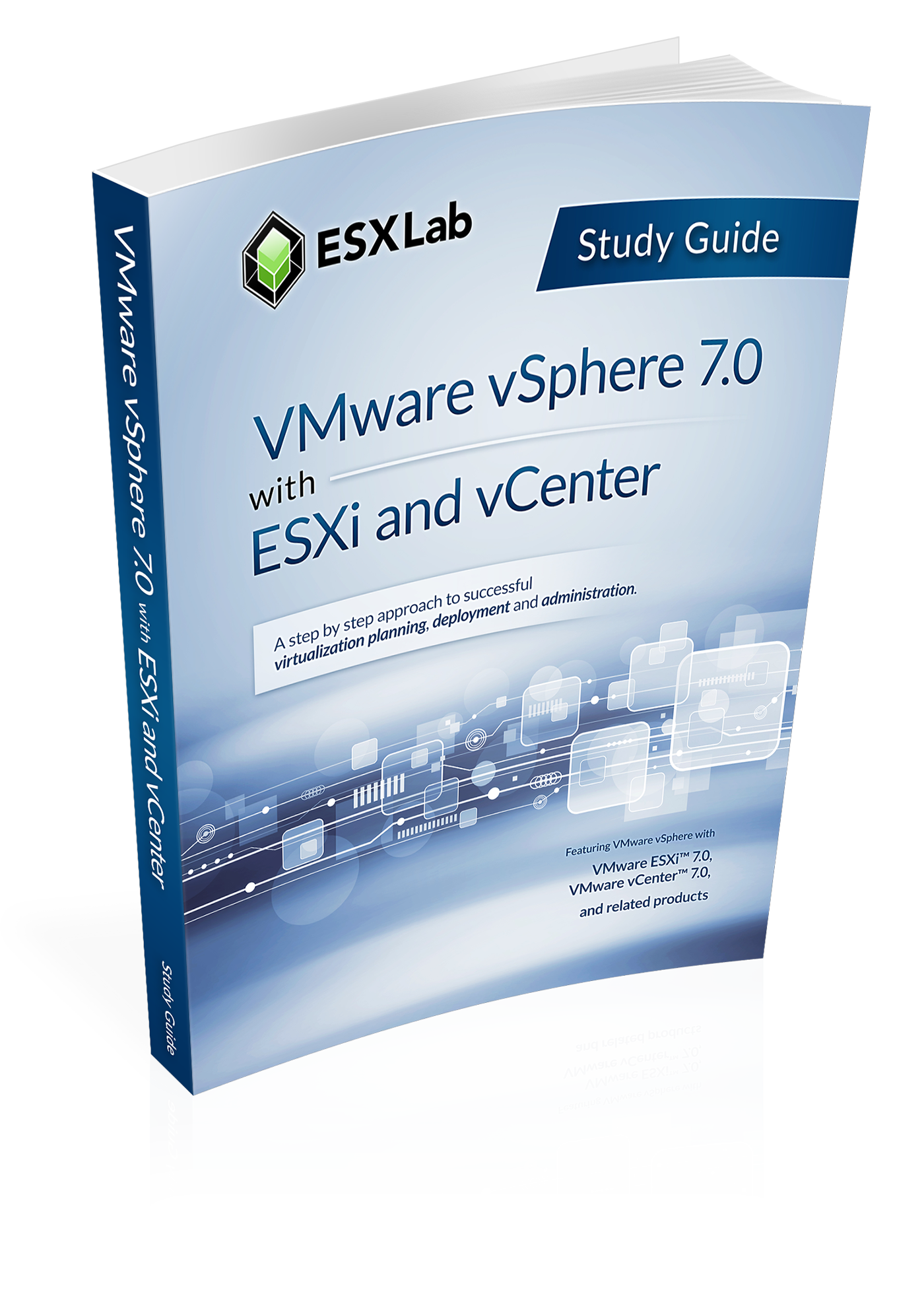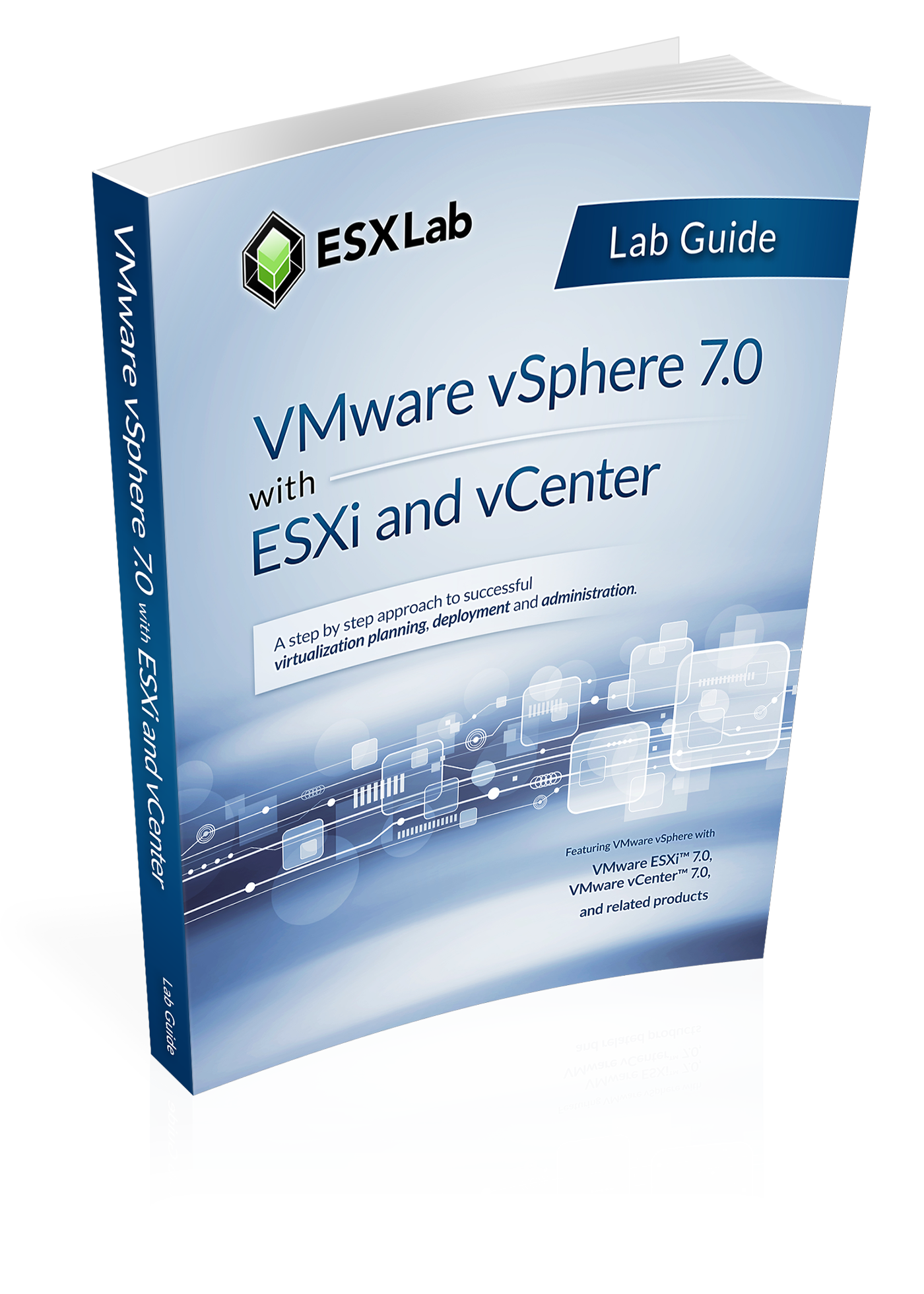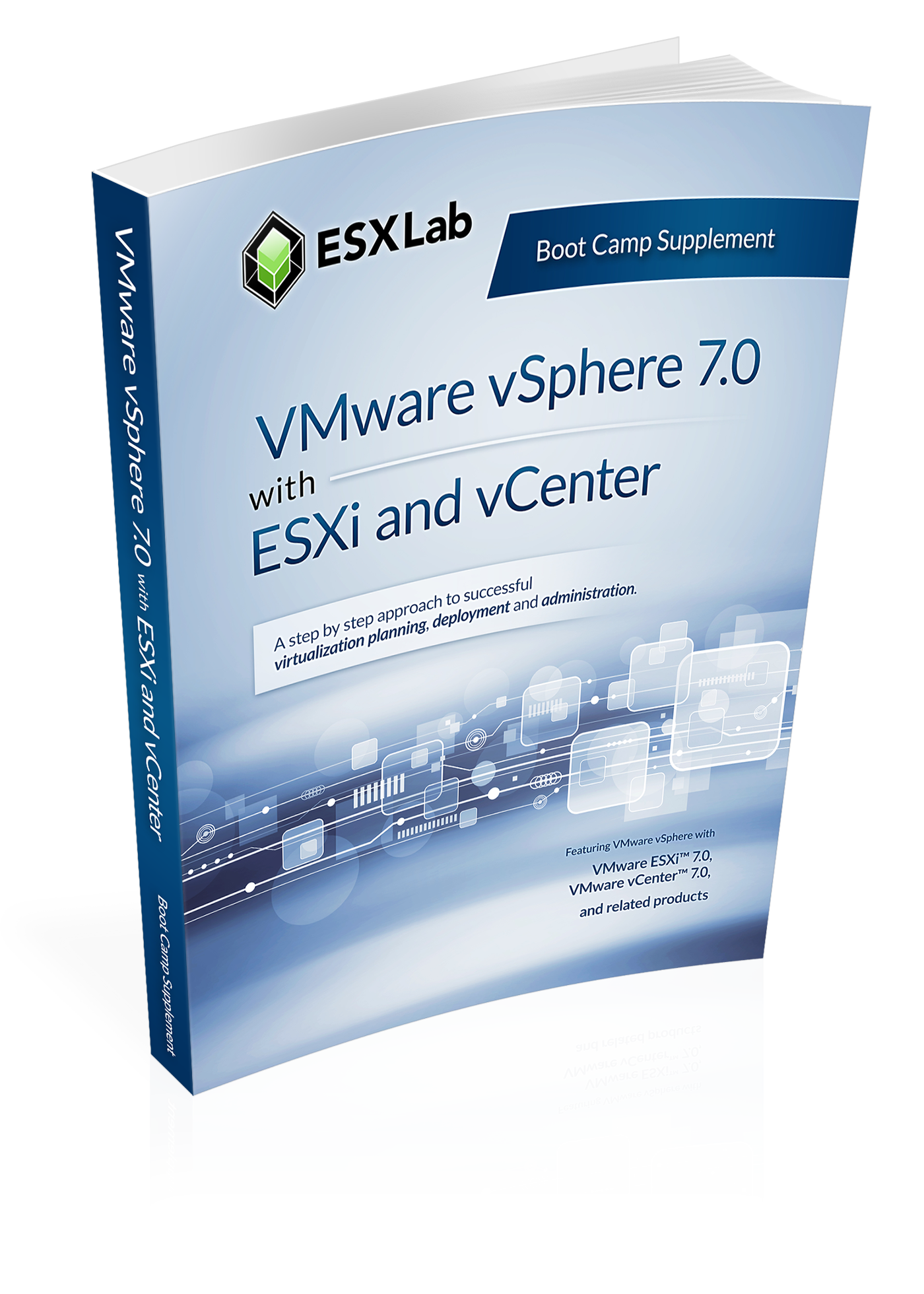   |
 |
|
 |
||
 |
|
VMware vSphere 7.0 Boot Camp |
||
|
Course Name |
VMware vSphere 7.0 Boot Camp |
|
|
Format |
5-day, 10 hours/day instructor led training |
|
|
Course Books |
647 pg Study Guide fully annotated with slide notes |
|
|
vSphere Version |
Based on VMware vSphere 7 Update 1 |
|
|
Delivery Options |
Instructor led on-site training. Instructor led distance learning. Instructor led mixed onsite and distance classes. Self paced video training with full lab access and instructor mentoring |
|
|
Remote Labs |
Remote access to dedicated rack of servers with one enterprise class PC Server per student, an iSCSI SAN, etc. |
|
|
Max Attendees |
We recommend you place no more than 16 attendees in a class |
|
|
Requirements |
Course can be run from any location that has a reliable Internet connection. Each attendee needs a PC that supports Microsoft Terminal Services |
|
|
Lab Time |
40+% of class time is devoted to hands-on labs |
|
|
Availability |
Released March, 2020. Last revised: July 2021 for ESXi 7.0 Update 1 |
|
|
Recorded Lectures |
Attendees of full instructor led classes receive lifetime access video recordings of all lectures |
|
|
Suggested Price |
$4,495 USD / seat |
|
Overview
This powerful 5-day extended hours class is an intensive introduction to VMware vSphere™ including VMware ESXi™ 7 and vCenter™ 7. This course has been completely updated to reflect the most recent changes introduced in vSphere 7.
Assuming no prior virtualization experience, this class starts with the basics and rapidly progresses to advanced topics. With 45+% of class time is devoted to labs, students learn the skills they need to become effective vSphere administrators.
Students use dedicated labs that start with installation and configuration of stand-alone ESXi servers and progress to shared storage, networking and centralized management. The class continues to advanced topics including resource management, high availability, replication, performance, disaster preparedness, rapid deployment and VM cold, hot and storage migration.
This class is unique in its approach; which is to identify and eliminate common IT pain points using vSphere. Students learn how to deliver business value; not just the technical or mechanical aspects of the software.
By the end of the class, attendees will have learned the skills, and best practices of virtualization. Attendees will be able to design, implement, deploy, configure, monitor, manage and troubleshoot vSphere 7.
Objectives
At the end of the course, attendees will be able to:
- Explain the many significant benefits of virtualization
- Install ESXi 7.0 according to best practices
- Use Host Client to manage standalone ESXi hosts
- Configure and manage local storage resources
- Create virtual and virtual to physical network configurations
- Configure and used Advanced vSwitch features including Teaming, Security and Jumbo Frames
- Define and use file share (NAS / NFS) datastores Create virtual machines, install operating systems and applications
- Create virtual machines, install operating systems and applications
- Install, configure and upgrade VMware Tools
- Install, configure and update vCenter Server Appliance
- Rapidly deployment of VMs using golden-master VM templates
- Create clones – one-time copies of virtual machine
- Use Guest OS customization to rapidly configure new VMs according to requirements
- Create Content Libraries to manage shared files
- Deploy VMs from Templates stored in Content Libraries
- Connect CD / DVD media in Content Libraries to a VM's CD / DVD reader
- Configure and use hotplug hardware including hot-add vCPUs and Memory
- Configure, manage, monitor and secure users and groups
- Understand the benefits and trade offs of network attached storage and Fibre, iSCSI SANs
- Configure and use shared SAN storage including Fibre SAN, iSCSI SAN
- Configure direct VM to SAN volume storage with Raw Device Maps
- Add and grow virtual disks including system disks and secondary volumes
- Use vCenter alarms to monitor ESXi, VM, storage and network health, performance, state
- Use Resource Pools to bulk delegate resource to meet Service Level Agreements
- Perform VM cold migrations, hot VMotion migrations and hot Storage VMotion migrations
- Configure and manage server CPU and Memory capacity and maintain VM responsiveness with Distributed Resource Schedule load balanced clusters
- Deliver high VM service availability using VMware High Availability clusters
- Provide zero unplanned VM downtime using vSphere Fault Tolerance
- Use HA to successfully minimize unplanned VM down time caused by ESXi host failures, storage network failures or SAN volume failures
- Patch and update ESXi servers using vCenter Lifecycle Manager
- Create Distributed Virtual Switches. Migrate VM and VMkernel networking over to dvSwitches
- Monitor and tune both ESXi and virtual machine performance
- Understand how VMware and third party products, including operating systems, are impacted by virtualization
- Troubleshoot common problems
Prerequisites
Attendees should have user, operator or administrator experience on common operating systems such as Microsoft Windows®, Linux™, UNIX™, etc. Experience installing, configuring and managing operating systems, storage systems and or networks is useful but not required. We assume that all attendees have a basic familiarity with PC server hardware, disk partitioning, IP addressing, O/S installation, networking, etc.
Who Should Attend
This class is suitable for anyone who want to learn how to extract the maximum benefit from their investment in Virtual Infrastructure, including:
- System architects or others who need to design virtual infrastructure
- Security specialists responsible for administering, managing, securing Virtual Infrastructure
- Operators responsible for day-to-day operation of Virtual Infrastructure
- Performance analysts who need to understand, provision, monitor Virtual Infrastructure
- Business Continuity specialists responsible for disaster recovery and high availability
- Storage administrators who work with Fibre / iSCSI SAN volumes and NAS datastores
- Managers who need an unbiased understanding of virtualization before committing their organization to a virtual infrastructure deployment.
Chapter List
Our class consists of the following chapters:
- Introduction to VMware vSphere 7.0
- How to Install, Configure ESXi 7.0 (HoL1)
- Introduction to Virtual and Physical Networking (HoL)
- Advanced Virtual Networking (HoL)
- Connecting to NAS / NFS Shared Storage (HoL)
- Virtual Hardware and Virtual Machines (HoL)
- How to Install and Configure vCenter Server Appliance 7.0 (HoL)
- VM Rapid Deployment using Templates, Clones (HoL)
- Content Libraries (HoL)
- Working with VM Hot Plug Virtual Hardware (HoL)
- The ESXi and vCenter Permission Model (HoL)
- Fibre, iSCSI and NFS v4.1 Shared Storage (HoL)
- Direct VM to SAN Volume access with Raw Device Maps (HoL)
- VMFS – VMware's Cluster File System (HoL)
- Virtual Infrastructure Monitoring with vCenter Alarms (HoL)
- Compute Resource Management with Resource Pools (HoL)
- VM Cold, Hot VMotion and Storage VMotion Migration (HoL)
- Load Balancing with Distributed Resource Scheduling Clusters (HoL)
- Rapid VM Failure Recovery with High Availability Clusters (HoL)
- Delivering Zero VM Unplanned Downtime with Fault Tolerance (HoL)
- Patch Management with VMware Lifecycle Manager (HoL)
- Introduction to Distributed Virtual Switches (HoL)
- Managing Scalability and Performance (HoL)
- Final Thoughts
1 HoL – Every attendee perform one or more Hands on Labs at the end of each chapter
Hands On Labs
Attendees will complete the following hands on labs during the class:
- Install of ESXi 7.0 and perform post-install configurations
- Create, update Network Standard vSwitches. Use NIC Teams for performance and redundancy
- Configure and test Jumbo Frames to improve physical networking performance
- Define, connect to and browse NFS file shares
- Create a Virtual Machine and install a guest OS into the VM. Install VMware Tools into the VM. Add 3rd party tools and utilities to the VM
- Export a VM in Open Virtual Machine Format (OVF) and then re-import it
- Install and configure the vCenter Server Appliance (vCSA)
- Configure Single Sign On (SSO) identity sources including Active Directory
- Configure vCenter's inventory views to organize inventory objects
- Work with Clones and Templates. Convert a VM into a template. Rapidly deploy new VMs from template. Copy VMs using cloning.
- Use guest OS customization to easily change the identity of a VM. Create, update and deploy VMs using Guest OS Customization Specifications
- Work with virtual disks
Hot add a secondary virtual disk
Grow a non-system volume
Grow a Windows system disk and partition with no down time - Create a new Content Library and upload a VM in OVF / OVA format to it
- Deploy a new Virtual Machine from a Template in a Content Library
- Connect an ISO file in a Content Library to a VM's CD / DVD reader
- Configure and test hotplug memory Create multi-core vCPUs
- Hotplug a new virtual CPU package into a running VM
- Work with vCenter permissions. Use and customize Roles
- iSCSI, Fibre Storage Area Networks. Scanning for and connecting to SAN shared storage
- Assign a SAN volume directly to a VM using Raw Device Maps
- VMware VMFS – VMware's cluster file system. How to create, tune and grow VMFS volumes
- vCenter alarms for monitoring key infrastructure objects. Send SNMP traps to a trap receiver on high VM resource consumption
- Create and resource tune Resource Pools. Test resource resource delegations
- Cold Migration VMs from one ESXi host and storage volume to another
- Hot VMotion the live running state of a VM from one ESXi host to another
- Hot Storage Migrate the live disk state of a running VM from one datastore to another
- Build and test an automated CPU and Memory resource load balancing DRS clusters
- Create and test an HA cluster. Watch the cluster place and restart VMs during a server failures
- Configure ESXi hosts, networking and VMs for Fault Tolerance
- Prepare for an IT failure with vSphere Replication. Hot replicate and then restore a running VM
- Set up VMware Lifecycle Manager to patch/update ESXi hosts. Perform an ESXi host Patch Scan, review host non-compliance with attached patch baselines and then apply patches to update the ESXi host
- Configure a Distributed Virtual Switch
- Migrate VM and VMkernel networking from standard vSwitches to dvSwitches
- Performance analysis and bench marking storage and networking
Detailed Chapter List
Chapter 1 - Introduction to VMware vSphere 7.0
- Virtualization explained
- How VMware virtualization compares to traditional PC deployments
- Common pain points in PC Server management
- How virtualization effectively addresses common IT issues
- VMware vSphere software products
- Hyperconverged Storage with VMware vSAN
- Hyperconverged Networking with VMware NSX
- What's New in vSphere 7.0
Chapter 2 – How to Install, Configure ESXi 7.0
- Understanding ESXi
- Selecting, validating and preparing your server
- Storage controllers, disks and partitions
- Software installation and best practices
- Joining ESXi to a Domain
- Local User Management and Policies
- First look at the VMware vSphere Host Client
Chapter 3 – Introduction to Virtual and Physical Networking
- vNetwork standard virtual Switches
- Virtual Switches, Ports and Port Groups
- Creating VMkernel NICs
- Creating, sizing and customizing Virtual Switches
Chapter 4 – Advanced Virtual Networking
- Explore advanced vSwitch properties
- Explain vSwitch Security properties and their use cases
- Explain the five NIC Teaming strategies, their implementation, pros, cons and use cases
- Explore Jumbo frames including how to test, configure and verify Jumbo frames
- Identify Jumbo frame use cases and where to avoid using Jumbo frames
Chapter 5 – Connecting to NAS / NFS Shared Storage
- Benefits Shared Storage offer to Virtual Infrastructure
- Shared Storage options
- NFS Overview
- Configuring ESX to use NFS Shares
- Configuring NFS for performance and redundancy
- NFS Use Cases
- Troubleshooting NFS connections
Chapter 6 – Virtual Hardware and Virtual Machines
- VM virtual hardware, options and limits
- Sizing and creating a new VM
- Assigning, modifying and removing Virtual Hardware
- Working with a VM’s BIOS
- VMware remote console applications
- Installing an OS into a VM
- Driver installation and customization
Chapter 7 – How to Install and Configure vCenter Server Appliance 7.0
- The need for Identity Source management
- Installing and configuring vCenter Server Appliance with embedded Platform Service Controller
- Connecting Single Sign On (SSO) to Active Directory and other identity sources
- vCenter feature overview and components
- Organizing vCenter's inventory views
- Importing ESXi 7 hosts into vCenter management
- Managing vCenter with vSphere Client
Chapter 8 – VM Rapid Deployment using Templates, Clones
- Templates - Virtual Machine Golden Master images
- Creating, modifying, updating and working with Templates
- Patching, and refreshing Templates
- Cloning, one time copies of VMs
- Best practices for cloning and templating
- Adding and resizing virtual disks
Chapter 9 – Working with Content Libraries
- The purpose, features and benefits of Content Libraries
- The 3 types of Content libraries and their use cases
- How to create a Content Libraries and upload VMs and media to them
- How to deploy a new VM from a template in a Content Library
- How to upload media images and use them from VMs
Chapter 10 - Working with VM Hot Plug Virtual Hardware
- Upgrade VM vHardware with no downtime with hotplug virtual hardware
- Preparing to hotplug vCPUs and vRAM into a running VM
- Hotplugging vNICs and vDisks into a running VM
- Hotplug Hardware and Guest OS support
Chapter 11 – The ESXi and vCenter Permission Model
- VMware Security model
- Configuring local users
- Managing local permissions
- vCenter security model
- Local, Domain and Active Directory users and groups
- How permissions are applied
Chapter 12 – Fibre, iSCSI and NFS v4.1 Shared Storage
- Fibre SAN overview
- Identifying and using Fibre Host Bus Adapters
- Scanning and Rescanning Fibre SANs
- iSCSI overview
- Virtual and physical iSCSI adapters
- Connecting to iSCSI storage
- Scanning and rescanning iSCSI SANS
- Performance and redundancy considerations and best practices
- Understanding the benefits of VMware VAAI compliant storage
Chapter 13 – Raw Device Maps
- Connecting VMs directly to SAN volumes using Raw Device Maps (RDM)
- RDM features, benefits and use cases
- Virtual and Physical RDMs explained
- How to set up and use RDMs
- How to correctly tear down RDMs
Chapter 14 – VMFS – VMware's Cluster File System
- Unique file system properties of VMFS
- Managing shared Volumes
- Creating new VMFS partitions
- Introduction to VMFS 6 features and capabilities
- Managing VMFS capacity with LUN spanning and LUN expansion
- Native and 3rd party Multipathing with Fibre and iSCSI SANs
- VMFS performance considerations
- VMFS scalability and reliability
Chapter 15 – Virtual Infrastructure Monitoring with vCenter Alarms
- Alarm categories and definitions
- Creating custom alarms and actions
- Reviewing alarms and acknowledging them
- Configure vCenter so it can send E-mail and SNMP alerts
- Work with alarm conditions, triggers and actions
- Identify most useful alarms to review and enable
Chapter 16 – Compute Resource Management with Resource Pools
- Delegate resources in bulk using Resource Pools
- How ESX delivers resources to VMs
- Shares, Reservations and Limits
- CPU resource scheduling
- Memory resource scheduling
- Resource Pools
Chapter 17 – VM Cold, Hot VMotion and Storage VMotion Migration
- Cold Migrations to new ESX hosts, datastores
- Hot Migrations with VMotion
- VMotion requirements and dependencies
- How VMotion works – detailed explanation
- How to test ESXi hosts and VMs for VMotion compatibility
- Troubleshooting VMotion
- Storage VMotion for hot VM disk migrations
Chapter 18 – Load Balancing with Distributed Resource Scheduling Clusters
- CPU and Memory resource balanced clusters with VMware Distributed Resource Scheduler
- Resource balanced clusters with VMware Distributed Resource Scheduler
- DRS Cluster configuration and tuning
- Per-VM cluster policy overrides
- Learn the features and benefits of DRS Power Management
Chapter 19 – Rapid VM Failure Recovery with High Availability Clusters
- High Availability options to minimize unplanned down time
- VMware High Availability clusters
- How VMware HA protects against ESXi host, storage network and SAN volume failures
- Introduction to VMware Fault Tolerance
Chapter 20 – Delivering Zero VM Unplanned Downtime with Fault Tolerance
- Introduction to continuous VM availability using VMware Fault Tolerance
- Configuring host networking to support Fault Tolerance
- Fault Tolerant protected VMs restrictions and limitations
- Configuring and enabling VM Fault Tolerance protection
- Testing Fault Tolerance and demonstrating zero VM unplanned downtime
Chapter 21 – Patch Management with VMware Lifecycle Manager
- Configure and enable VMware Lifecycle Manager
- Establishing a patch baseline
- Verifying compliance and patching ESXi hosts
Chapter 22 – Introduction to Distributed Virtual Switches
- Introduction to dvSwitch features and capabilities
- Create, configure a dvSwitch
- Migrating VMkernel NICs from standard to dvSwitches
- Bulk migrate VMs from standard to dvSwitches
- dvSwitch configuration backup and restore
Chapter 23 – Managing Scalability and Performance
- VMkernel CPU and memory resource management mechanisms
- Tuning VM storage I/O performance
- Identifying and resolving resource contention
- Monitoring VM and ESX host performance
- Performance and capacity planning strategies
Chapter 24 – Final Thoughts
- Consolidation guidelines for VMs and Storage
- Determining which workloads to consolidate
- Other considerations
For More Information
This class can be customized to meet your unique training and delivery needs, including:
- On-site delivery at your facility
- Custom timetables including 3-day rapid delivery boot-camps
- Content and Lab customization to meed your unique training needs
- Distance training
- Mentoring, implementation planning and assistance
For group discounts or content for instructor lead deliveries please contact your authorized ESXLab.com training partner, or sales@esxlab.com